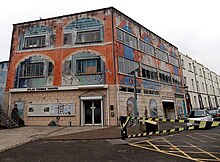
The Dylan Thomas Theatre is a theatre in the Maritime Quarter, in the centre of the city of Swansea in Wales. The theatre officially opened under its present name in 1983, [1] but was home to the Swansea Little Theatre from 1979.

The Dylan Thomas Theatre is a theatre in the Maritime Quarter, in the centre of the city of Swansea in Wales. The theatre officially opened under its present name in 1983, [1] but was home to the Swansea Little Theatre from 1979.
The Swansea Little Theatre is an amateur drama group based at The Dylan Thomas Theatre and was the first Little Theatre in Wales. The theatre group began performances from 1924 and was based at various different locations during its early years.
In the early 1930s, the poet Dylan Thomas became a member of the troupe after first reviewing plays by the Little Theatre for the South Wales Evening Post. [2] [3] In 1932, he appeared with the group for a production of Noël Coward's Hay Fever , taking the role of Simon. A local critic wrote that Thomas was "an artist with an explosive temper and untidy habits". Thomas appeared in plays with the theatre for the next two or three years. [3] The group maintained its link with Thomas' family when his daughter, Aeronwy Thomas-Ellis, became president of the theatre.
In 1979, Swansea City Council offered the Swansea Little Theatre the derelict former Oscar Chess showroom and garage, in an area which had been earmarked for development, as a permanent home. On 29 September 1983, Sir Harry Secombe officially opened the theatre, now named the Dylan Thomas Theatre. [4]
51°37′01″N3°56′14″W / 51.61689°N 3.93722°W
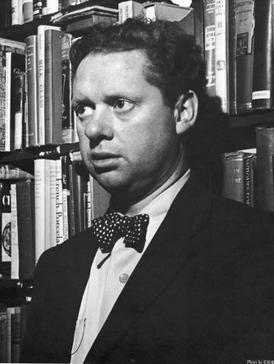
Dylan Marlais Thomas was a Welsh poet and writer whose works include the poems "Do not go gentle into that good night" and "And death shall have no dominion", as well as the "play for voices" Under Milk Wood. He also wrote stories and radio broadcasts such as A Child's Christmas in Wales and Portrait of the Artist as a Young Dog. He became widely popular in his lifetime; and remained so after his death at the age of 39 in New York City. By then, he had acquired a reputation, which he had encouraged, as a "roistering, drunken and doomed poet".

Swansea is a coastal city and the second-largest city of Wales. It forms a principal area, officially known as the City and County of Swansea.
Under Milk Wood is a 1954 radio drama by Welsh poet Dylan Thomas. The BBC commissioned the play, which was later adapted for the stage. The first public reading was in New York City in 1953.

New Quay is a seaside town, community and electoral ward in Ceredigion, Wales; it had a resident population of 1,045 at the 2021 census. Located 19 miles (31 km) south-west of Aberystwyth, on Cardigan Bay with a harbour and large sandy beaches, the town lies on the Ceredigion Coast Path and the Wales Coast Path. It remains a popular seaside resort and traditional fishing town, with strong family and literary associations with the poet Dylan Thomas and his play, Under Milk Wood.

Vernon Phillips Watkins was a Welsh poet and translator. He was a close friend of fellow poet Dylan Thomas, who described him as "the most profound and greatly accomplished Welshman writing poems in English".

Swansea Castle is located in the city centre of Swansea, Wales, UK. It was founded by Henry de Beaumont in 1107 as the caput of the lordship of Gower. The castle is now ruined and only two blocks remain, though the site has been improved in the 2010s for use as a public space.

Gower is a constituency created in 1885 and represented in the House of Commons of the UK Parliament by one Member of Parliament (MP). Tonia Antoniazzi of the Labour Party became its MP after winning it from Conservative Byron Davies in the 2017 UK general election. Labour had previously represented the seat from 1909 until 2015.

The Maritime Quarter is a residential area of Swansea, Wales, immediately south of the city centre shopping core. It falls within Swansea's Castle ward. The area is bounded by Brynmill to the west, Swansea Bay to the South, the River Tawe to the east and the A4067 to the north.
Mount Pleasant is a suburban neighbourhood of Swansea, Wales. The area is centred on the main road, called Mount Pleasant, immediately to the north of Swansea city centre, which connects the city centre to the Townhill and Mayhill districts to the north. It falls partly within the Castle ward and Uplands wards. The demographic of the area changed in recent years with the expansion of the former Swansea Metropolitan University campus on the main Mount Pleasant road and the arrival of a substantial student population.
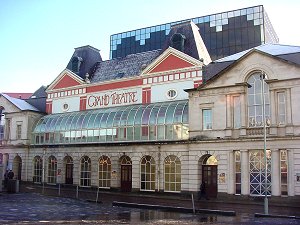
Swansea Grand Theatre is a performing arts venue in the centre of Swansea, Wales. The theatre stages plays, pantomimes and touring theatrical acts visiting Swansea. Swansea Grand Theatre was the base for the UK's only Russian ballet company, the Swansea Ballet Russe.
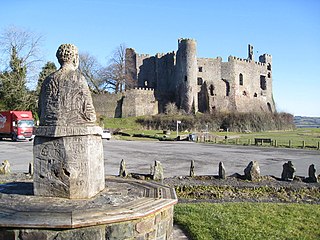
Laugharne Castle is in Laugharne, Carmarthenshire, Wales. The castle, located on the estuary of the River Tâf, was originally established in 1116. It was rebuilt as a Norman stronghold. There have been many alterations since then, including becoming a Tudor fortified manor house in the sixteenth century. It changed hands twice during the English Civil War, being eventually captured by Parliamentary forces in 1644.
John Ormond, also known as John Ormond Thomas, was a Welsh poet and film-maker.
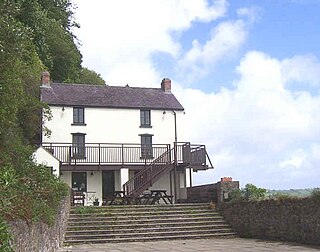
The Boathouse in Laugharne, Wales, was where Dylan Thomas lived with his family during his last four years between 1949 and 1953. The house is set in a cliff overlooking the Tâf estuary and is where he wrote many of his major pieces. It has been suggested that he wrote Under Milk Wood here but more recent research suggests that fewer than 300 lines of the play were written in Laugharne.

Cwmdonkin Park is an urban park situated in the Uplands area of Swansea, Wales. It has a children's play area, water gardens, tennis courts, and a bowling green. The park is known for its associations with Dylan Thomas, and is listed on the Cadw/ICOMOS Register of Parks and Gardens of Special Historic Interest in Wales.

The Quadrant Shopping Centre is the principal under-cover shopping centre in Swansea, Wales. The centre opened in 1979. From the 1980s to 2019 it was home to the Swansea Devil, a controversial carved wooden statue of the Devil.
Charles Fisher was a Welsh journalist, writer, poet and adventurer. Until 1953 he was based in Britain; afterwards, in Canada.

Nigel Jenkins was an Anglo-Welsh poet. He was an editor, journalist, psychogeographer, broadcaster and writer of creative non-fiction, as well as being a lecturer at Swansea University and director of the creative writing programme there.
Sandfields is a district in Swansea, Wales bounded by St. Helen's Road to the north, Oystermouth Road and Swansea Bay to the south and Dillwyn Street to the east. The area is adjacent to and immediately west of Swansea city centre. The district does not exist officially as a geographical area or a local authority community area. Sandfields also does not have a specific postcode.
James Morgan is a Welsh actor.
Glanmôr School was a secondary school in Swansea in south Wales, founded as Glanmor Central School for boys and girls in 1922 and closed by merger with Bishop Gore Comprehensive School for Boys in 1972. "Glanmôr", or "Glan y Môr", means "seaside" in English. It was situated on Glanmor Hill in Uplands in wooden ex-army buildings. As a central school it had a status between secondary and elementary until 1930, when it was defined as a secondary school. The buildings were requisitioned for the US army during the Second World War, and the boys' school closed in 1941. The girls' school continued as a grammar school until 1972. When the presence of high alumina cement in support structures of other Swansea schools caused their closure in 1974, its buildings were re-used by Olchfa Comprehensive School for two years. The site was cleared in August 1989 and replaced with housing, with the new streets named after some of the school's houses.